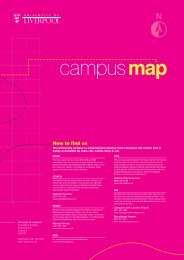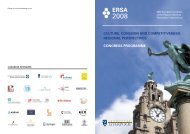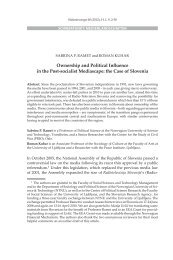The Scientific and Humane Legacy of Max Perutz - Molecular ...
The Scientific and Humane Legacy of Max Perutz - Molecular ...
The Scientific and Humane Legacy of Max Perutz - Molecular ...
Create successful ePaper yourself
Turn your PDF publications into a flip-book with our unique Google optimized e-Paper software.
ESSAY<br />
Society), <strong>and</strong> over a hundred Fellowships <strong>of</strong> the Royal Society<br />
conferred upon its staff–merits closer enquiry. An overwhelmingly<br />
important factor in all this is the way that <strong>Perutz</strong><br />
organized the Laboratory <strong>and</strong> his own role within it.<br />
<strong>Perutz</strong>, from the outset, adopted a new style <strong>of</strong> management.<br />
Thus he once wrote:<br />
I persuaded the MRC to appoint me Chairman <strong>of</strong> a<br />
Governing Board, rather than as Director... This arrangement<br />
reserved major decisions <strong>of</strong> scientific policy to the<br />
Board, <strong>and</strong> left their execution to me... <strong>The</strong> board met only<br />
rarely... This worked smoothly <strong>and</strong> left me free to pursue my<br />
own research. Seeing the Chairman st<strong>and</strong>ing at the laboratory<br />
bench or the X-ray tube, rather than sitting at his desk,<br />
set a good example <strong>and</strong> raised morale. <strong>The</strong> Board never<br />
directed the laboratory×s research but tried to attract, or to<br />
keep, talented young people <strong>and</strong> gave them a free h<strong>and</strong>∫.<br />
As his former PhD student <strong>and</strong> distinguished molecular<br />
biophysicist, Pr<strong>of</strong>essor David Blow, [24] who was a member <strong>of</strong><br />
the LMB in its early days, said recently <strong>of</strong> <strong>Perutz</strong>:<br />
He always recognized the importance <strong>of</strong> new instrumental<br />
developments, <strong>and</strong> maintained large mechanical <strong>and</strong> electronic<br />
workshops, to which research workers had full access,<br />
directly passing their enthusiasm to the technical staff∫.<br />
However, over <strong>and</strong> above these technical features <strong>of</strong><br />
running a laboratory, <strong>Perutz</strong>, ably assisted by his devoted<br />
<strong>and</strong> shrewd wife Gisela, made the canteen at the LMB a focal<br />
point for intellectual stimulus. It was–<strong>and</strong> still is–visited<br />
three times a day by most scientists <strong>and</strong> associated staff, <strong>and</strong> it<br />
remains an important center for the exchange <strong>of</strong> ideas <strong>and</strong><br />
scientific news. One American molecular biologist [25] on<br />
sabbatical leave in 1985 at the LMB commented that, because<br />
the canteen was the intellectual center <strong>of</strong> the laboratory, one<br />
could not stray <strong>of</strong>f course in one×s researchwork for more<br />
than a period <strong>of</strong> three hours! <strong>Perutz</strong> himself kept abreast <strong>of</strong><br />
everybody×s work, by making a habit <strong>of</strong> sitting with different<br />
groups <strong>of</strong> people at c<strong>of</strong>fee time, lunch, or tea. (He did likewise<br />
whenever he came to lunch at his college, Peterhouse.)<br />
<strong>Perutz</strong> led by example, [26] he aimed to spend some 90 % or<br />
more <strong>of</strong> his time working at the bench, <strong>and</strong> he expected others<br />
to do likewise. But he recognized <strong>and</strong> could cope with<br />
differences in individual style. In reflective mood, he once<br />
wrote:<br />
When Crick <strong>and</strong> Watson lounged around, arguing about<br />
problems for which there existed as yet no firm experimental<br />
data instead <strong>of</strong> getting down to the bench <strong>and</strong> doing<br />
experiments, I thought they were wasting their time. However,<br />
like Leonardo, they sometimes achieved most when<br />
they seemed to be working least, <strong>and</strong> their apparent idleness<br />
led them to solve the greatest <strong>of</strong> all biological problems, the<br />
structure <strong>of</strong> DNA. <strong>The</strong>re is more than one way <strong>of</strong> doing<br />
good science∫.<br />
Every now <strong>and</strong> then, <strong>Max</strong> <strong>Perutz</strong> wrote in one <strong>of</strong> his recent<br />
books (I Wish I×d Made You Angry Earlier: Essays on<br />
Science, Scientists, <strong>and</strong> Humanity), I receive visits from<br />
earnest men <strong>and</strong> women armed with questionnaires <strong>and</strong> tape<br />
recorders who want to find out what made the LMB (where I<br />
work) so remarkably creative... I feel tempted to draw their<br />
attention to 15th century Florence with a population <strong>of</strong> less<br />
than 50 000, from which emerged Leonardo, Michelangelo,<br />
Ghiberti, Brunelleschi, Alberti, <strong>and</strong> other great artists. Had<br />
my questioners investigated whether the rulers <strong>of</strong> Florence<br />
had created an interdisciplinary organisation <strong>of</strong> painters,<br />
sculptors, architects, <strong>and</strong> poets to bring to life this flowering<br />
<strong>of</strong> great art?... My question is not as absurd as it seems,<br />
because creativity in science, as in the arts, cannot be<br />
organised. It arises spontaneously from individual talent.<br />
Well-run laboratories can foster it, but hierarchical organisation,<br />
inflexible, bureaucratic rules, <strong>and</strong> mountains <strong>of</strong><br />
futile paperwork can kill it. Discoveries cannot be planned;<br />
they pop up, like Puck, in unexpected corners.<br />
In an age when the Paladins <strong>of</strong> accountability <strong>and</strong> the<br />
Funding Councils persist in preaching the necessity for all<br />
academic researchcenters to have a Mission Statement <strong>and</strong><br />
Strategic Plans, it is prudent to recall how <strong>Perutz</strong> set about<br />
founding <strong>and</strong> running the extraordinarily successful LMB. <strong>The</strong><br />
principles he used were: choose outst<strong>and</strong>ing people <strong>and</strong> give<br />
them intellectual freedom; show genuine interest in everyone×s<br />
work, <strong>and</strong> give younger colleagues public credit; enlist skilled<br />
support staff who can design <strong>and</strong> build sophisticated <strong>and</strong><br />
advanced new apparatus <strong>and</strong> instruments; facilitate the<br />
interchange <strong>of</strong> ideas, in the canteen as much as in seminars;<br />
have no secrecy; be in the laboratory most <strong>of</strong> the time <strong>and</strong><br />
accessible to everybody where possible; <strong>and</strong> engender a happy<br />
environment where people×s morale is kept high.<br />
However, the LMB in Cambridge is not the only major<br />
laboratory in which <strong>Perutz</strong> had a h<strong>and</strong> in creating. Shortly after<br />
the Nobel ceremony in Stockholm in 1962, Leo Szilard <strong>and</strong><br />
VictorWeisskopf<strong>of</strong>theUnitedStatescalledtoseeWatson,<br />
Kendrew, <strong>and</strong> <strong>Perutz</strong> to discuss the prospects <strong>of</strong> establishing a<br />
European <strong>Molecular</strong> Biology Organisation (EMBO) like the<br />
Nuclear Science Centre (CERN) in Geneva. All three<br />
responded enthusiastically. Supported by other European<br />
molecular biologists, notably Francois Jacob (France), FriedrichFreska<br />
(Germany), Ole Maalo (Denmark), Jeffries<br />
Wyman (USA), <strong>and</strong>, crucially, Ephraim Katchalski-Kazir<br />
(Israel), Kendrew led the way, <strong>and</strong> soon EMBO came into<br />
being with<strong>Perutz</strong> as its Chairman from 1963 ± 1969. In due<br />
course, the European <strong>Molecular</strong> Biology Laboratory (EMBL)<br />
at Heidelberg, <strong>of</strong> which John Kendrew was the founding<br />
Director (for ten years), also came into being. [27]<br />
Haemoglobin <strong>and</strong> its Impact on Medicine<br />
In 1959 when <strong>Perutz</strong> <strong>and</strong> his colleagues first unraveled the<br />
architecture <strong>of</strong> the haemoglobin molecule in outline, it was<br />
appreciated by all concerned that it was not the end <strong>of</strong> their<br />
journey. As <strong>Perutz</strong> put it:<br />
...our much-admired model (<strong>of</strong> haemoglobin) did not<br />
reveal its inner workings–it provided no hint about the<br />
molecular mechanism <strong>of</strong> respiratory transport. Why not?<br />
Well-intentioned colleagues were quick to suggest that our<br />
hard-won structure was merely an artefact <strong>of</strong> crystallisation<br />
3160 ¹ 2002 WILEY-VCH Verlag GmbH & Co. KGaA, Weinheim 1433-7851/02/4117-3160 $ 20.00+.50/0 Angew. Chem. Int. Ed. 2002, 41, No.17





